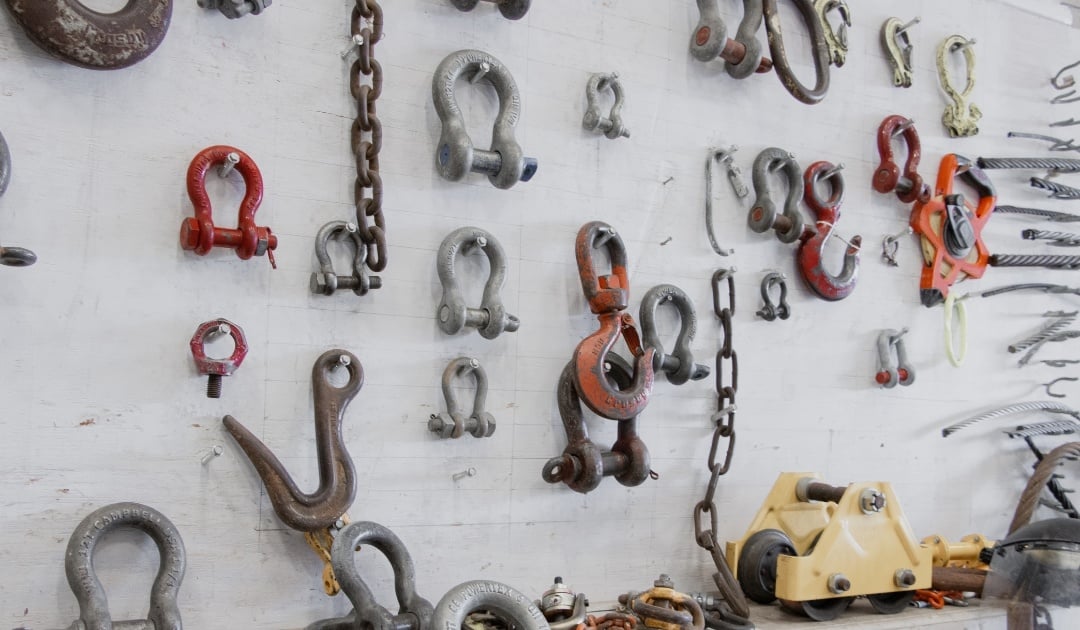
One of the biggest questions among riggers is, “What type of hardware should I use?” There are many different types of hardware in the rigging industry. Let us dive in and talk about them.
Different Types of Rigging Shackles

Shackles are one of the most used rigging hardware in the industry today. The problem is that most riggers do not know the proper way to use a shackle or what type of shackle is best. You have two main types of shackles a screw pin shackle and bolt pin shackle. These shackles come in many sizes and are designed for different applications.
Using Screw Pin Shackles for Rigging
Screw pin shackles, also known as screw pin-type shackles, are primarily used for quick job turnarounds due to the ease of attaching and detaching them to loads.
The biggest question I always hear is, do we put the pin in the hook or bowl in the hook? The easy answer is whichever way is best suited for the lift. If you are using multiple slings, the best way would be to use the pin in the hook.
How do we properly secure the pin-type shackle? Well, it must be fully threaded, and the shoulder of the pin touching the body of the shackle. This can be found in ASME B30.26 section (26-1.9.4 A).

Using screw pin shackles to make choker hitches
Sometimes, a rigger will use a shackle to create a choke hitch on a sling. It makes connecting and disconnecting the hitch easy but attaching it the right way is critical. You must put the eye of the sling on the pin of the shackle.
You will always hear people say quarter turn back after you tighten the shackle. This would be incorrect, and you would purposely be making the pin loose, putting the lift in danger. The ASME B30.26 Section (26.9.4 H) further emphasizes not turning the shackle pin a quarter turn back.
Using Bolt Pin Shackles for Long-Term Installations
Next, we will discuss bolt pin shackles, also known as bolt-type and bolt shackles. Riggers use these shackles for long-term installation. The shackle pin is threaded with a nut and has a place for a cotter pin at the end.
Installing a bolt pin shackle is a straightforward process. Simply slide the pin through the holes in the shackle's body, apply the nut, and secure it with the cotter pin. This ensures the nut stays in place, preventing it from coming off the pin.
Having the cotter pin is necessary when using the bolt-type shackle because that is how it was designed by the manufacturer to be utilized. This is in the B30.26 section (26-1.9.4 i). The pin has an engineered opening so that you may use a spud wrench or other item to apply leverage to negate the need or want to pursue the practice of backing off the pin. The design factor for a shackle is 5 to 1 until you hit over 150 tons; then, it is a 4 to 1 ratio.
Using Eyebolts Correctly for Rigging

Next, we are going to talk about eyebolts. Eyebolts are commonly found on loads already connected, but how do you know how to properly connect the eyebolt or what direction you can pull it?
The straightforward way of doing this is checking to see if the eyebolt has a shoulder under the eye. If the eyebolt has a shoulder, it can be used for angled lifting within a limited range and in line with the plane of the eye. If there is no shoulder, the eyebolt is designed for vertical lifts only.
Using Turnbuckles to Get the Right Sling Length
A less common piece of hardware is the turnbuckle. The turnbuckle is used to lengthen your sling when needed. Most people will daisy chain shackles to help, but this puts unneeded wear on the shackle and extra weight. Unequal loading on the pins and bowls could cause the shackles to slide or shift when loading them. This could compromise your lift.
Turnbuckles are designed to give slings a variable length while reducing your rigging weight and equipment to a minimum. When using these, they must be in line with the sling, so the weight to look at would be tension weight, not load weight.
Turnbuckles come with ends like jaws, eyes, or hooks. Hooks are not used for lifting. They are used for guying or plumbing and are significantly weaker than the jaws and eyes. Always use a wrench on the flats of the turnbuckle when tightening. Never put anything in the body, as this will bend the housing and degrade the turnbuckle.
Swivel Hoist Rings

Swivel hoist rings are very versatile and highly adaptable to dynamic loads. Something to pay attention to is making sure that the swivel is free to rotate 360 degrees. There is a bushing on the bottom of the swivel that must be in contact with the load.
A mistake that can be made when choosing a swivel hoist ring to handle a load is basing the capacity on the weight of the load. The tension that will be placed on the sling is the force the ring needs to be able to bear, which must be calculated correctly. Swivels are designed to carry the tension weight.
Manufacturers specify the torque that swivel hoists must be placed in to be used securely. Always secure the swivel to the manufacturer's specifications. This will ensure that you are safely using the swivel.
Master Links (Also Known as Connection Rings)

The most overlooked piece of rigging hardware is the master link/connection ring. These are very versatile pieces, commonly called D-rings in rigging slang. Utilizing connection rings is extremely helpful when using multiple slings on a lift. The allowable angle of use is 120 degrees, unlike hooks, which are only 90 degrees.
These are usually found in bridle setups but are especially useful on their own. On a hook alone, you can fit only two slings. With the right collector ring, you can attach multiple slings and rigging hardware.
Hooks Used for Rigging
When thinking about hooks in lifting, the first thing that often comes to mind is their use on the crane regarding their various headache ball and block configurations. Hooks also appear on several rigging hardware items. They can be seen in various bridle systems throughout the lifting world. There may be some confusion about whether these hooks fall under similar regulations and standards for other hooks.
Luckily for us, most hooks follow the same requirements and recommendations. As easy as that makes applying hooks connected to rigging with proper training, it is important to understand the difference between what is required by law, what is an industry-standard, or a strongly supported suggestion.
For comprehensive information about hooks and their standards, reliable sources such as 1910.184, 1926.251, and the B 30.10, along with other publications, are invaluable. These sources provide detailed insights, including the standard inspection items of 5% throat opening, 10% metal loss, and 0-degree twist, which are widely accepted standards.
At the end of the day, if something were to go wrong, ignoring strongly supported suggestions can be used against you. If OSHA shows up to investigate an accident, one of their main questions will be, "What did you do to establish a safe work environment?" Following what is legally required is generally considered the minimum for establishing a safe workplace. Following the latest industry standards relevant to your operations can be regarded as one of the best practices.
When applying a hook to the load, it's crucial to always face the hook out. This simple practice prevents the hook from dislodging in slack conditions, ensuring safety. It also eliminates the risk of the hook moving so that you pick up on the tip instead of picking in the bowl. Custom-designed hooks are marked to indicate safe working loads and must be proof-tested to 125% if the rated load is used before use. OSHA 1926.251 (a)(4).
Tying it all Together
While these are more common types of rigging hardware, there is a variety of specialized equipment for specific cases, such as below-the-hook devices, that your team may need to master for your operations. CICB offers a variety of rigging courses that are customizable to your exact operations, so your team can safely and efficiently handle loads.
About The Author
 Larry Kime brings over two decades of experience to CICB, serving as a Senior Instructor/Inspector and Technical Advisor. A U.S. Air Force veteran, Larry has dedicated his career to promoting safety and compliance in the lifting industry. Known for his engaging teaching style and deep technical expertise, he is highly regarded by professionals across the field. Larry’s commitment to continuous learning and mentorship makes him a valued member of the CICB team.
Larry Kime brings over two decades of experience to CICB, serving as a Senior Instructor/Inspector and Technical Advisor. A U.S. Air Force veteran, Larry has dedicated his career to promoting safety and compliance in the lifting industry. Known for his engaging teaching style and deep technical expertise, he is highly regarded by professionals across the field. Larry’s commitment to continuous learning and mentorship makes him a valued member of the CICB team.





